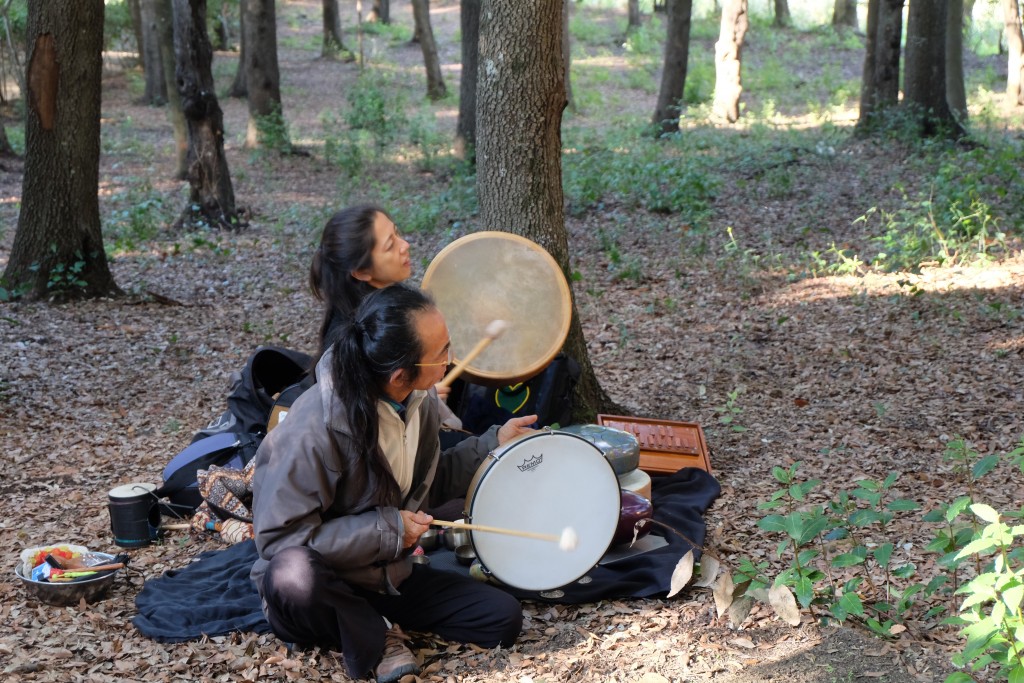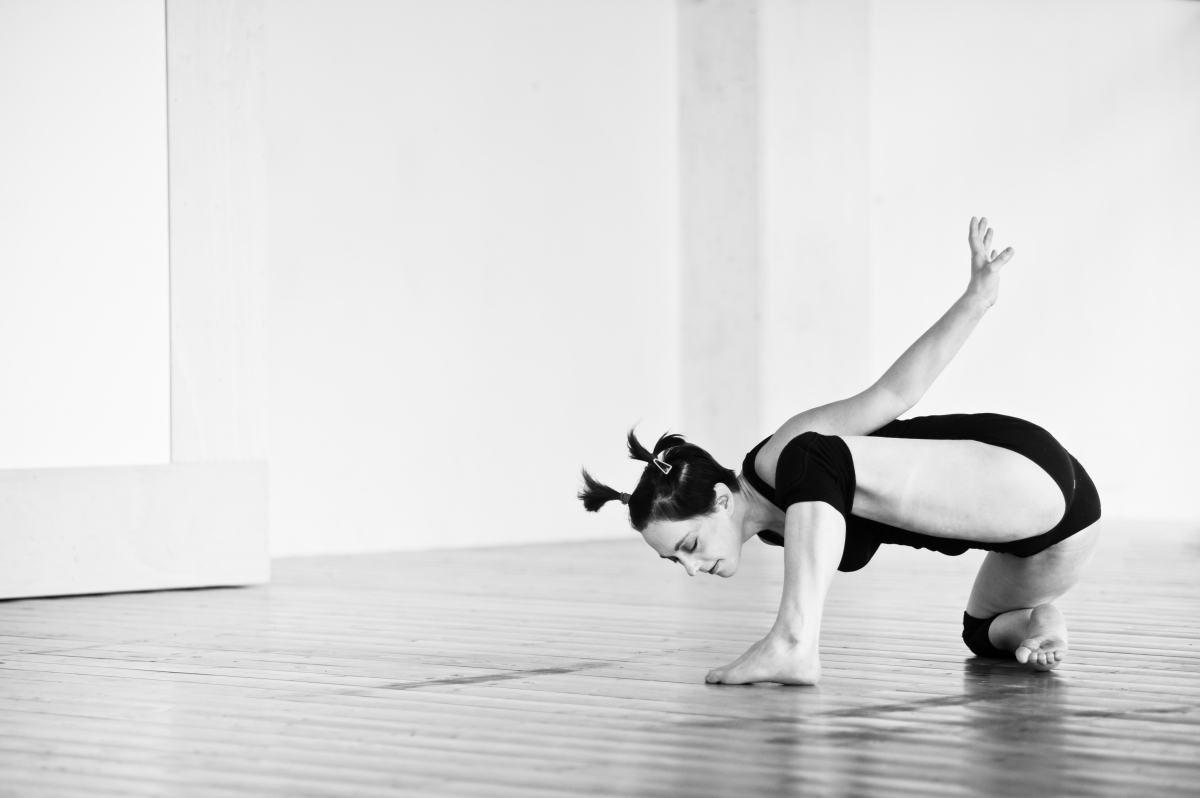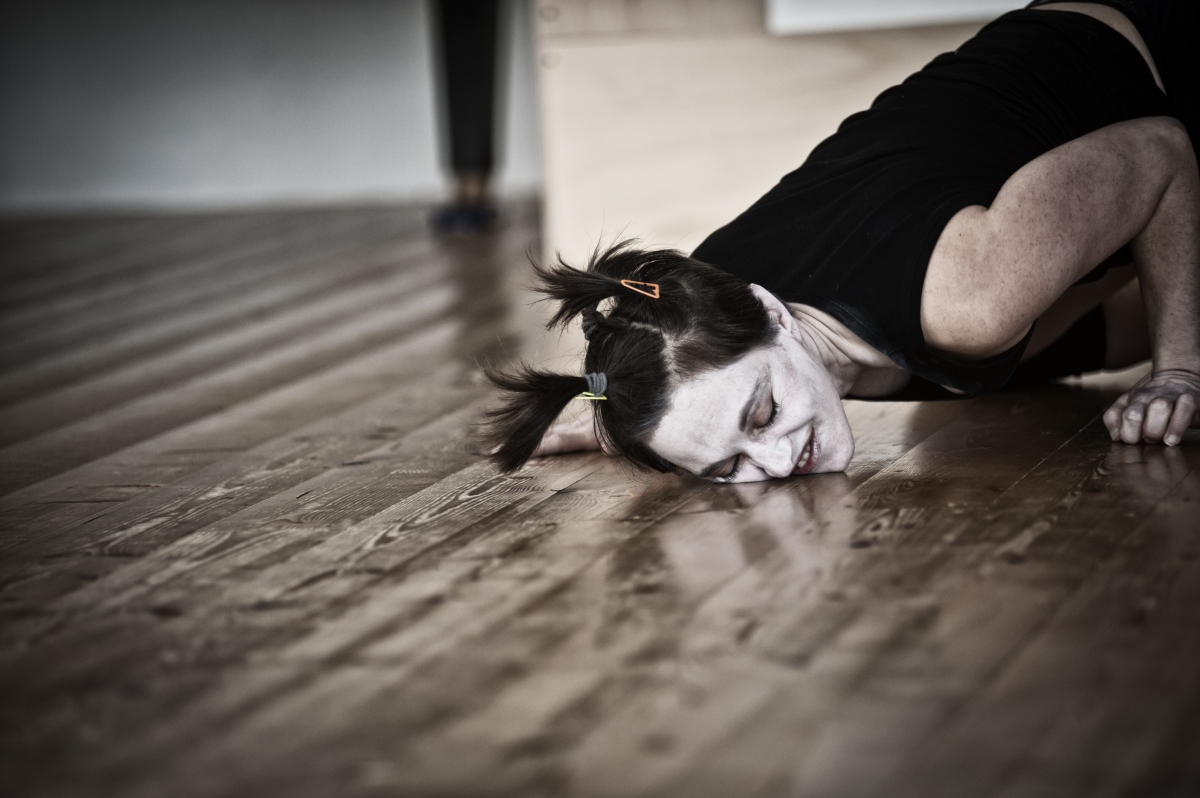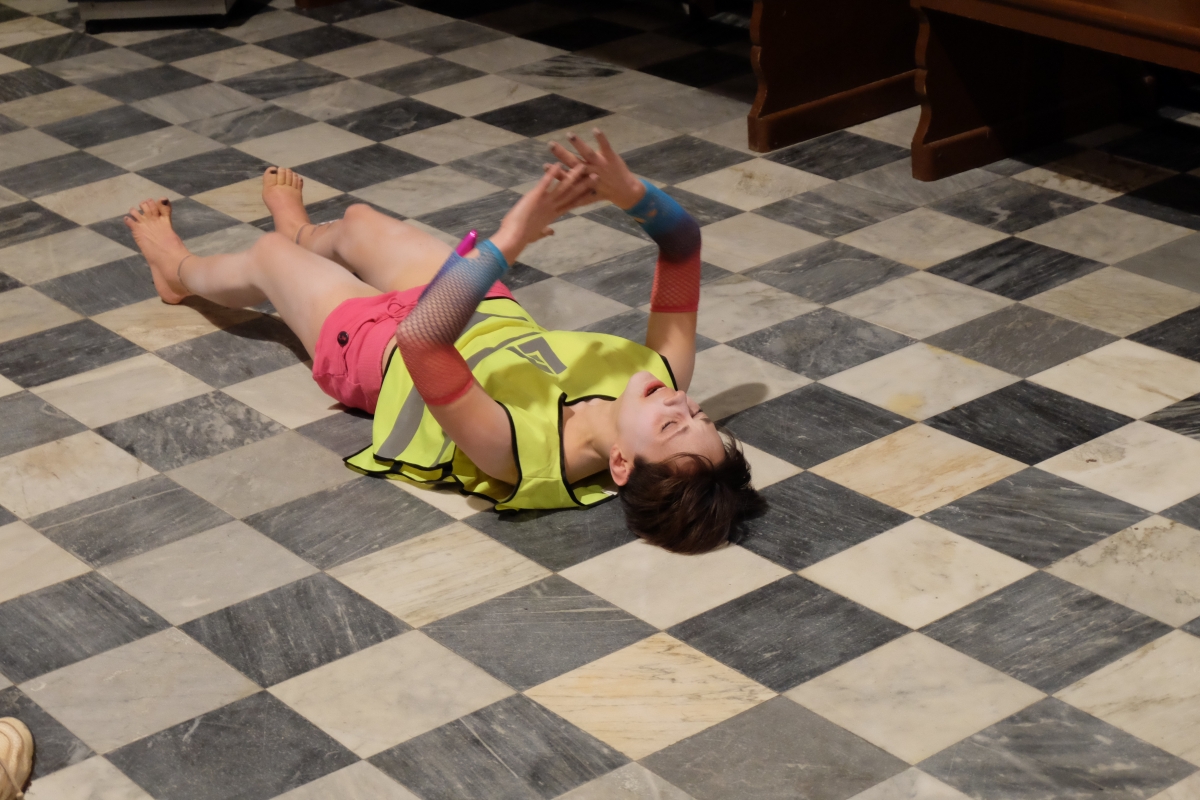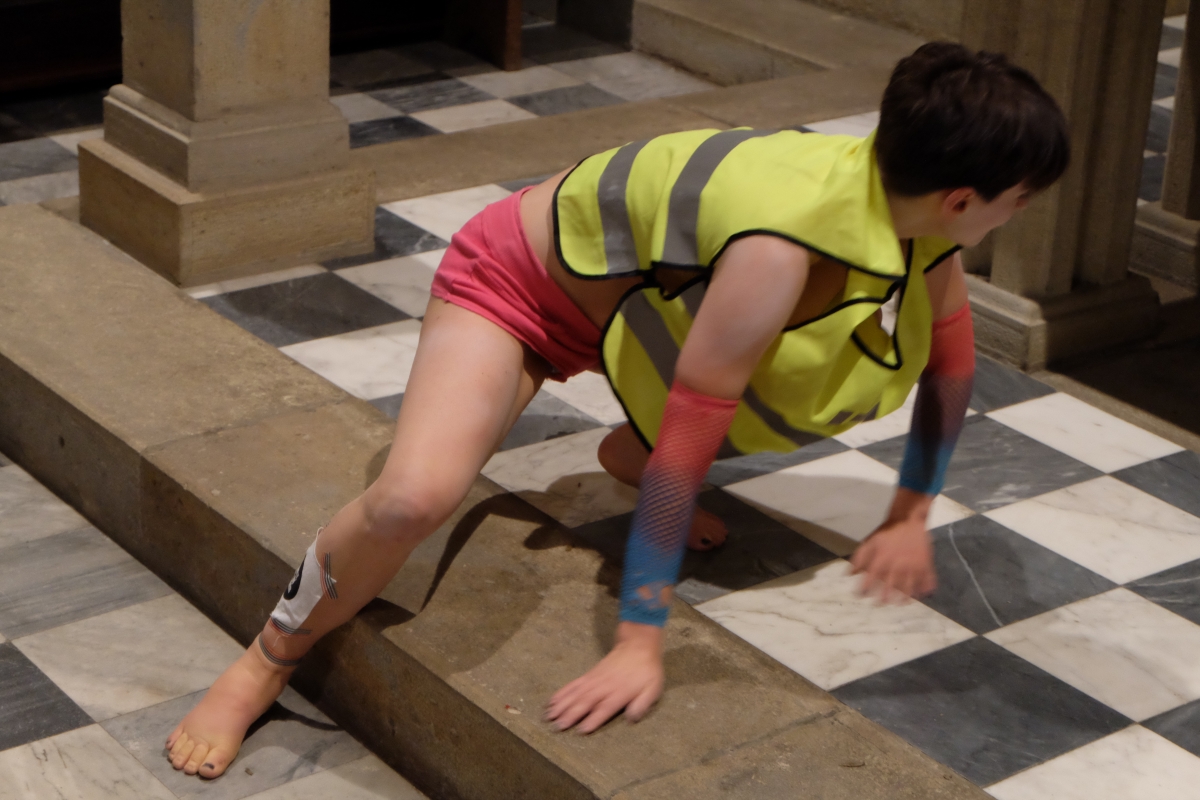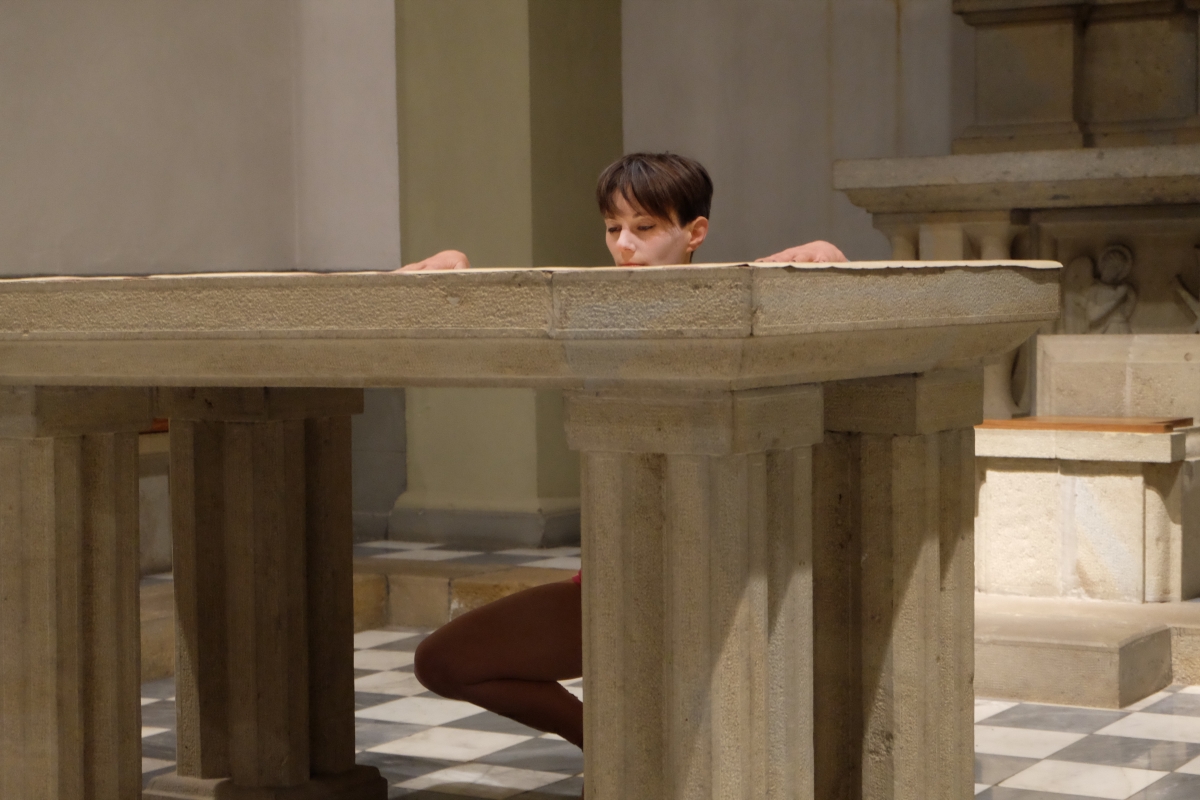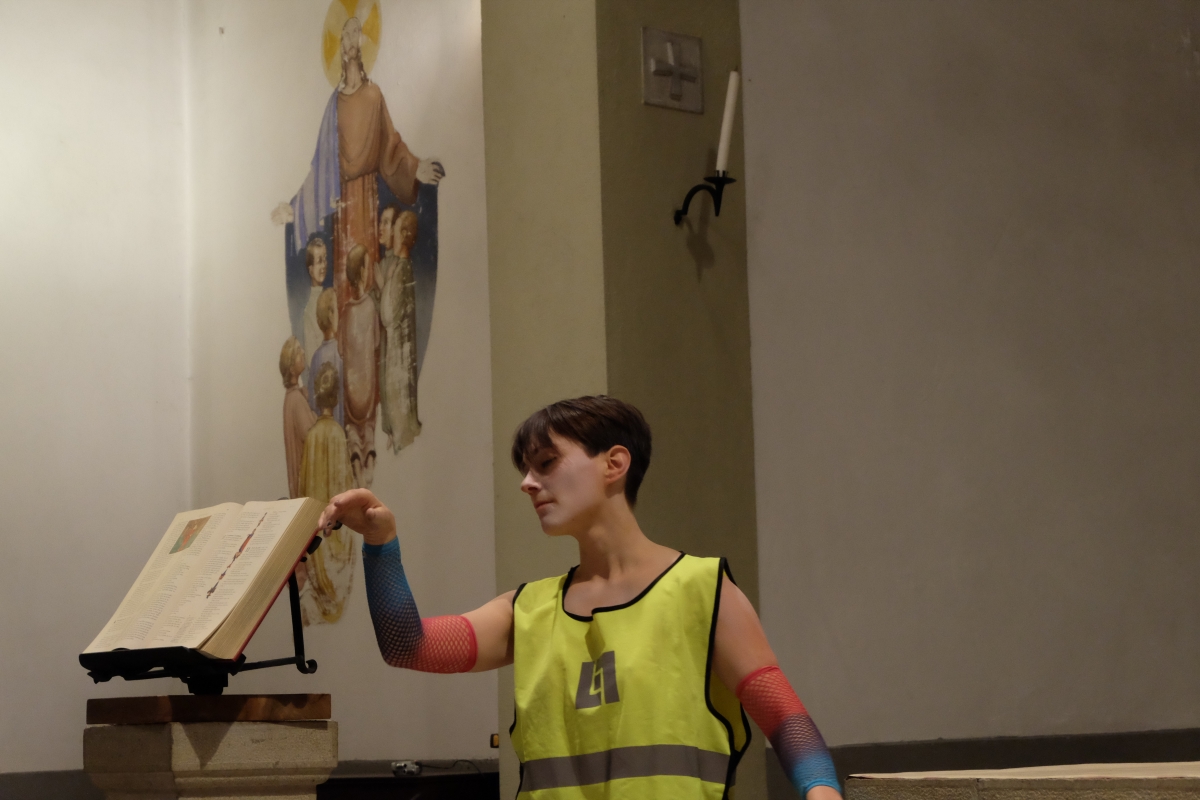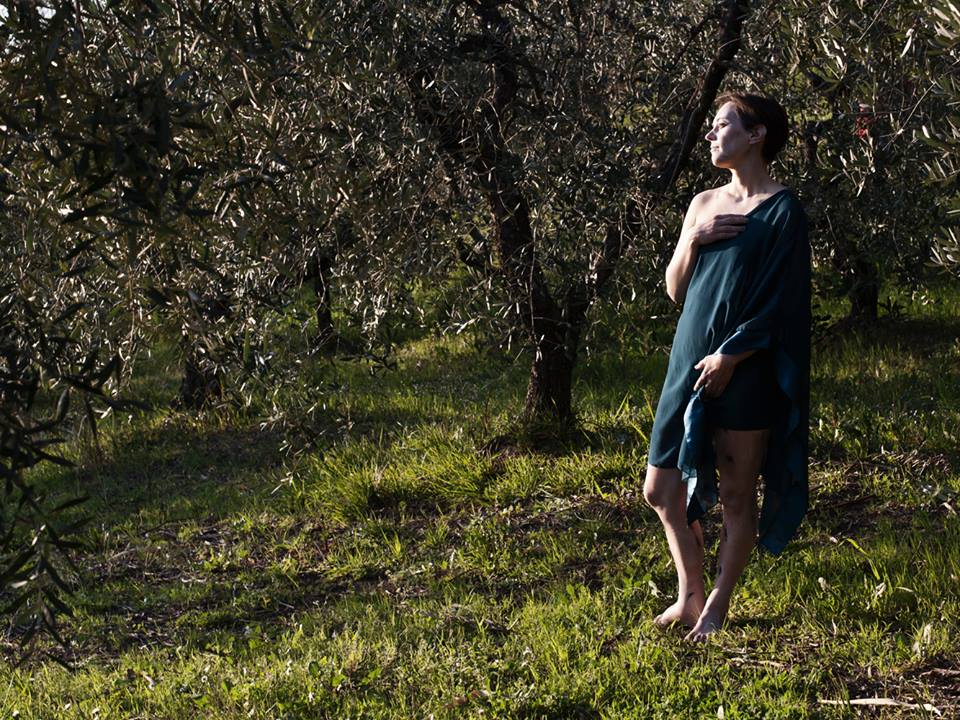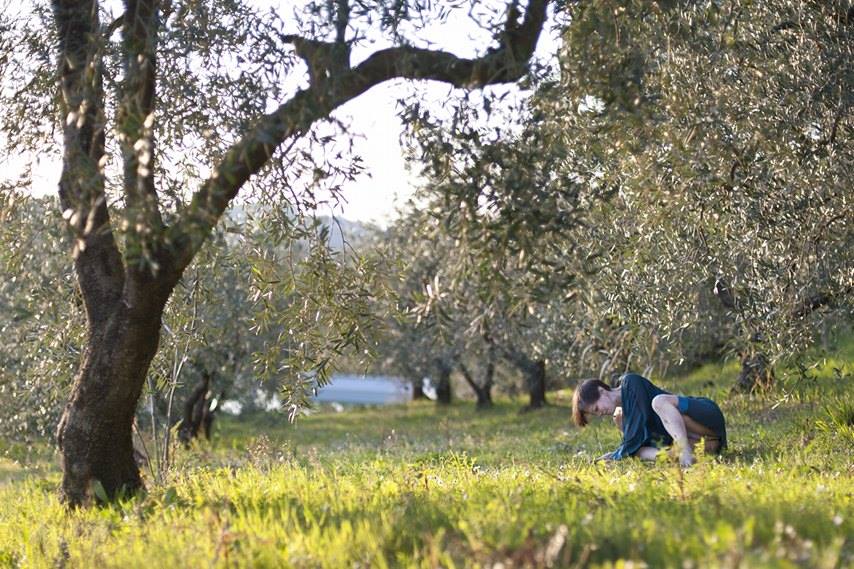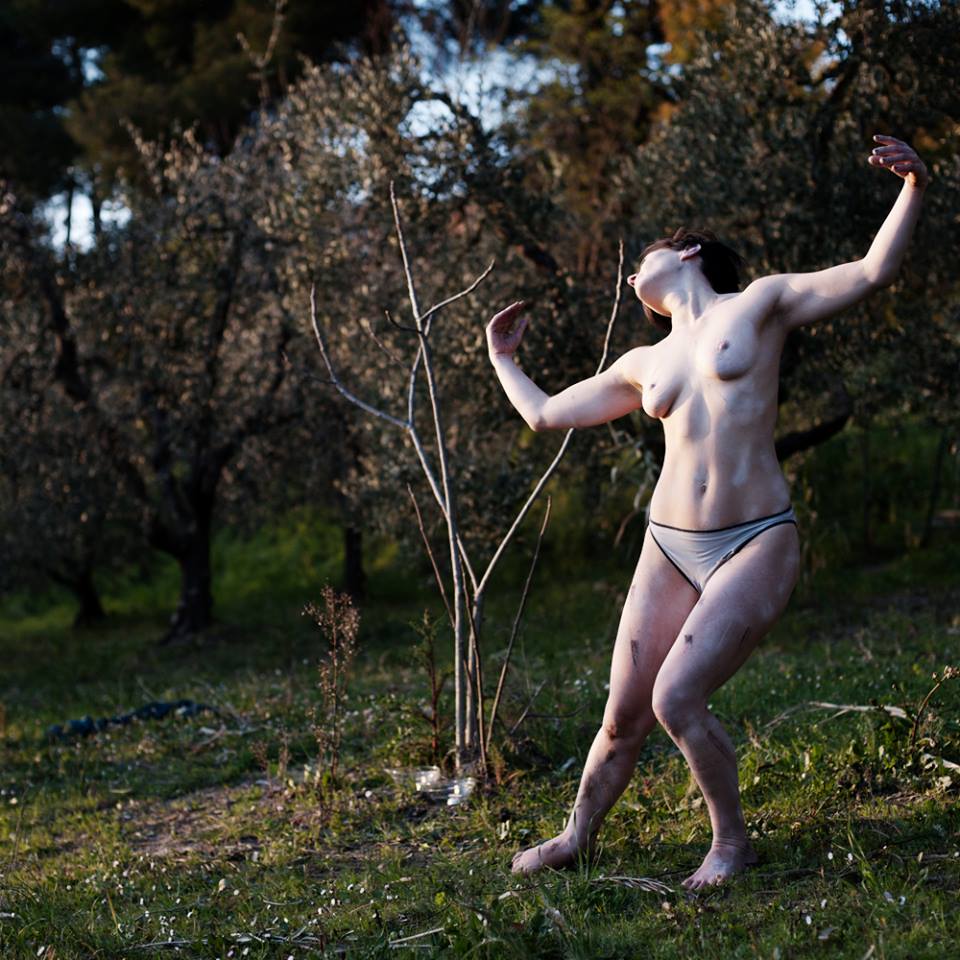Jinen Butoh School
with Atsushi Takenouchi, dance,
Hiroko Komiya, live music,
and Maruska Ronchi, assistant.
(warning: the text below is not a crash course on butoh, but about personal experiences with an art form being part
of the butoh family)
Ready or not?
When I discovered Butoh many years ago, I felt sooo impressed. I was amazed by the wonderful intensity of the performers but also by the pureness of their emotions. At the time, I was only “acting”, admiring their power, wishing I could do/be the same. Butoh is not forced feelings or the free demonstration of anger or sadness in white paint. Butoh in nature is not just stones, wind, watery movement and lofty trees. Butoh is a state of the soul, reflected in a body on the edge of crisis. And you have to be ready to practise Butoh. Ready to face your own darkness. Then, you can empty yourself and start a new journey from a beautiful emptiness.
Several years ago, I attended a 5-day workshop with Minako Seki, at TanzFabrik Berlin. Her technique had an eye-opening impact on me. It wasn’t so much about the art itself, it was more about me. I noticed that my body could not endure some exercises, even though they were very easy. I still had some graceful and powerful improvisations but felt crushed deep within. During one of these improvs, I experienced the void, my own enormous void, followed by a serious panic attack. It wasn’t the first time. I’d had a similar one in the past during an intimacy workshop for actors but dismissed it as much as I could. Was it time to face the terror in me? My body was trying to tell me something, to remind me of facts I’d done everything I could to hide mentally, for years. Had I been raped? really? me? when?
If I was going to work with my body and my emotions as an actor or a mover, I would have to consider this carefully or I would not be able to go far. Since what consciousness seems to forget, the body always remembers.
So instead of diving into butoh, I continued my contemporary dance training, all the while working on my trauma, trying to come to terms with it through support and counselling.
I saw a lot of “butoh” performances. But it was never quite the same, everyone had their own way of butohing and I started to wonder what real butoh is. Where could I be taught? For more than a 10-day workshop?
Why Jinen Butoh?
Along with stage performance, I love site-specific improv, flowing outdoors with nature as a score, or some piece of incidental artwork found on the street. I had practised in Australia, on my own, and I was looking forward to deepening this aspect of my work. And because I felt I could relate to elements of Atsushi Takenouchi’s philosophy based on nature and alternative thinking, I thought enrolling for the 6 month school would do me good.
During that year in Capannace, Palaia—a place lost between Pisa and Firenze— about 18 of us, of all ages and walks of life, were guided by Atsushi, Hiroko, Maruska and Alessia Mallardo as a helper. Some, who were very fond of Atsushi’s work, came to explore the form without imperatives. Some came to deepen their performance skills. Others to overcome private issues through the ritual and shamanic aspects of Jinen Butoh. I didn’t quite know what to expect. I was brave enough to dive in without being sure I would enjoy the live music performed. Hiroko’s voice is heavenly, reminding me of Björk when she’s singing the icy wind, and her tempi and tones are truly moving. But after a short while, I could confidently state that I am not a fan of metallic percussion, Tibetan bowls and crotales included. Besides, if I can perform without strong gong bangs, so much the better, and everyone can choose their own music for their own solo. Some like it drummy and shrilly. The beats make them go faster I guess…
Ego & GROOOOOOOOOOUP life
A little research on butoh reveals rather quickly that this art is mastered through the “loss of ego”. Erm, ok, but right from the beginning, everyone is showing their ego through their performance. Kind of normal: just showing what we can do, demonstrating our skills. So Atsushi leads us calmly and slowly-slowly on a meditative practice. Every day, we rehearse ash-walking, zero-walking, suriashi. Yeah, let’s disappear from this life and walk like spirits on water.
But how and why should we get rid of our inner sense of being to perform? I came back to the stage because I wanted to SAY something. Because we are not here to perform meaning. Oh, maybe I should think again then. Because I don’t want to perform art for art’s sake. Inner struggle. Maybe I should not think at all and train myself to breathe in and out like a ghost, maybe I should let it all rain on me and keep on smiling.
So jinen butoh is rather meditative and the outcome is nothing like dance-theatre or physical theatre. The performers are not spelling out a clear message. And whoever comes from these fields must unlearn their habits and enter a new world. You do not show the flower to the audience, your inner flower shows you what to do.
Of course, as a result of shedding layers and layers of ego in the studio, eeeekgo comes right back, when you’re out of the studio. And the needy energies of all participants are floating in the air. So very tangible. 17 people around me, asking for love and recognition. What do I want? Where do I stand? Of course I want to be loved too. So on the one hand we train for a beautiful emptiness in class, on the other we need to fill this void with a lot of hugs, loud songs and congrats clapping in the evening.
It took me months to understand and accept the process at work within me and the others and the bond tying me to the group.
Living as a group means sharing all life duties and not just a room. We get up together, we practice yoga together, we prepare breakfast, lunch and dinner together, we clean the premises and wash dishes together, along with our common training (7 hours a day). So there was no private space, no time for the self (all the better for the loss of ego) and no real time to digest what was going on inside me as I was performing the abandoned dog on a deserted street after the world has collapsed, or when I was relentlessly carrying stones in a concentration camp to the magnificent but sickening music by Henryk Górecki.
One minute I’m crying like mad because I’m a little girl without legs who will never be able to walk, the next I’m in the kitchen to chop carrots and find a compromise with my “happy-cooking group” for the lunch menu preparation. And I cannot focus because I’m already starving!
Yes, group life means letting go of personal habits, adjusting them for a while, without losing one’s sense of balance. After ten years of shared housing in London, Sydney and Berlin, I really wished I had my own flat and just had to turn up to class… but this would have been too easy.
We had to undergo a full butoh process, to empty ourselves of the past and start something new. Because some aspects of what I could define as “butoh spirit” are also ingrained during social time. We say ohio gozaimass every morning and we bow slightly when saying aligato or sumimasen (meaning I’m sorry). It may be an amusing hint at Japanese culture but, conversely, it’s also a way of getting into Japanese habits.
Over time I adopt the habit of not judging the needs and behaviour of others, of finding out what it is that I really want, and check in with myself quickly whether I am doing something because the group is doing it or because I really want to. Stay honest. Stick to your truth. Without showing off. Yes I am different, a free spirit, but how will this reflect on my sense of exclusion/inclusion later on?
Tight schedule
When I write “6 months” it’s actually 13 days of work per month with a break in between to digest, recover, and do some paid work to pay the tuition – like the founders of butoh did in the past in Japan since they had no funding. Office clerks during the day, club dancers in the evening, training butoh overnight. Or maybe this art form is for hyperactive people who really need to calm down and finally experiment with very slow moves?
As a trained mover I didn’t find yoga/basics too hard or super advanced level either. Atsushi really cared for the whole group and supported everyone in their abilities. Respect your body first. So I had to go to acrobatics or capoeira during days off to channel my hyper-spiralling energy.
Classes were varied, alternating with samples from Hijikata Tatsumi and Ohno Kazuo’s (plus Yoshito) work and personal anecdotes. Taking time to let our body and soul understand what their work meant. Taking time to recognize their shapes vs. our favourite shapes. To refine our dance and really let all the useless flourishes drop to the floor.
We had a lot of space for improvisation. At times, I wished for more technique and work in silence, but for this there is Sankai Juku and their 5-day workshop. In the end, I really learned to detect my style, the beast in me, and go for it.
Atsushi’s work is very sensitive, emotional and slightly provocative. It’s up to the participants to use their own tools and to decide what to do with them. No one is forced to work with nudity or fundoshi (traditional underwear in Japan) but students wishing to explore this option are given respect.
We are always free to build our solos and feedback is given lovingly and personally, when asked. Sometimes in a group setting. Everything is done to cultivate our inner flower and stress our successes. Weaknesses are not pinpointed and no one is demotivated despite inevitable failures. At Jinen Butoh School, we help each other blossom and when we go through life crises because our deeply held beliefs are shattered by the majority’s will, we are prompted to step back and meditate.
In fact, individuals are faced with their own limits throughout the group journey, and need to accept things as they will not alter the opinion of the majority.
Feminine vs. masculine
To me, there is no such thing as feminine or masculine energy, all the more so when these adjectives are used respectively as synonyms for soft // WAVE // feminine and strong // VOLCANO // male. This polarised cis-tem which belittles so many people makes me angry and I have tried my best to explain my theory, rationally. I find it absurd to hear again and again expressions like “a strong woman” or “an effeminate man” implying these people do not fit the qualities patriarchy assigns to their supposed gender. Even though we are all aware that human beings can be strong and soft and all the gradients in between.
I was looking for coherent and non-deprecating examples. However, saying something like “the women I like are masculine, while the men I like are feminine” would only deepen the confusion between gender and sexuality and perpetuate the artificial tug of war… that has more to do with desire for power than humanness.
In fact, patriarchy and binary thinking have caused profuse atrocities and created a lot of unjust and sexist structures many societies still rely on, sadly. So I stand for equality, equity of attributes, regardless of the biological bodies given to us, regardless of sexual orientation (which – again – has nothing to do with the concept of gender).
I wish for a post-gender world were “herma”, “FtoM trans”, “MtoF trans”, “cis female”, “intersex”, “cis male” are nothing but HUMAN BEINGS [silent prayer that I didn’t hurt or forget any existence]. We are all the elements – fire, water, wind and earth – all the shades of the rainbow, and what a beautiful world it would be if we could start thinking BEYOND gender.
BUT, as a member of a school celebrating yin and yang, as a(n unwilling) part of a binary society, I have to accept that some people see themselves as a blend of male and female energies and the way patriarchal society has analysed nature (see La Douceur de l’ombre, a book on trees by Alain Corbin) is not helping.
So I tried to redirect my anger and frustration on this topic in a poem called Beyond and to incorporate it into a Requiem to the binary cis-tem in November. And when I read texts from First Nation People (like the Two-spirited People of Manitoba or “Our Coming in Stories”) who had a non-binary vision of the world and its inhabitants, I smile and tell myself, still, there is hope.
Working with nature, even indoors
Atsushi’s curriculum does not follow some kind of pyramid shaped methodology. As a participant you can jump in for a month or two or the totality. (Yes be mad, just do it!) Atsushi starts by exploring one basic element per month (wind, ground, fire, water), and spices it up with breath technique, specific scenarios coming from the founders of Butoh. His beloved trainings on “four seasons” and “Dionysus vs. Apollo” are very present too – as are the drums and the Indian accordion reminding us of the ritual aspect of dance.
Every day in studio, after the sun has set behind the olive trees and my beloved eucalyptus, we dance a tree, dialogue with the moon, implore the rain or call spring, depending on our inner feeling and how we let it come to the surface of our body. And we push it. We test the edge of your limits. How far can we push? Some say everything is possible if we disobey what well-wishing society dictates us to do. Do not shrink and forget about the real essence of life. Let your inside grow and glow.
And when class is over, and the cooking group of the day gone to their task, Atsushi stays available to reply to any question we may have.
For better or worse?
Eventually, once we overcame the fire in us and its stormy damages in December, once we overcame the circulation of water and fever in January, February came as a blessing, a new breath, and March as a wonderful reunion for a long week of performances outdoors, in a chapel, a ghost hamlet, Pontedera city and our very private silver green grove.
At the end of the day, everything made sense: the journey from the inside to the outside, the big brother feeling and the silent teachings. Several readings helped me fill in the gaps. And in opening myself to all of the participants, for all of them are lovable and WONDERful, in going through so many “transformation dances”, in embracing my own darkness, I now know where I stand as a performer.
But I also know that I stand at the threshold of something new, I just reached fresh territory to explore and sooner or later I will return to one of Atsushi’s workshops to get more answers. And I am thankful and grateful for all the shared experiences, in solo, duet and group. Dance is a gift. Hopefully we can meet again and do more human ikebana on a street anywhere in Europe.
The school is organised through Spazio Nu, a gorgeous place for dance and movement in Pontedera, run by a young, warm and welcoming team. Thank you Massimo and Floriana for your interest in alternative ways of life and your guests full of JOY.
Readings and films which helped me along
François CHENG, Qui dira notre nuit?
Akira MIZUBAYASHI, Petit éloge de l’errance
The Taste of Tea, a film by Katsuhito Ishii
USHIO AMAGATSU et Kyoko Iwaki, published by Actes Sud
Butoh by Sondra FRALEIGH
Butô(s), CNRS éditions
BIG thanks to E. Puzzuoli for pix on this page; (c) A. Stach for the Requiem to binary society
